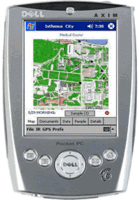DC & space -- John's Thoughts
 What is the role of space and place in distributed cognition (DC)? Here are my thoughts:
What is the role of space and place in distributed cognition (DC)? Here are my thoughts:DC places a lot of emphasis on the role of artifacts as they mediate our behavior and contribute to our cognition. I think I could easily argue that one such tool that mediates our behavior, and lessens the mental energy we spend cognating (is that even a word?) is a road. We build a road to help us get from place A to place B, but the road also marks the way; it directs us; it channels us. The road is a man-made artifact.
I could make the argument then, that the trail and the pathway are also artifacts. They do the same as the road on a smaller scale. But what about a deer trail? Is it not an artifact because it was made by deer? Or does it become an artifact once it is "repurposed" for human use? I think it does, just as the "old oak tree on the hill" becomes an artifact when it is repurposed as a landmark. The space of the hill becomes a place "Old Oak Hill" when it is given the consequential meaning of guidance (Schweber 2005).
I would further argue that the importance of the place in DC is amplified when the meaning of the place is enriched. Turning right at Old Oak Hill to get to grandmother's house gives Old Oak Hill one level of meaning, but having direct (or indirect) experience there gives it symbolic meaning (Schweber 2005) which can play a much richer role in DC. For example: having your first kiss in a tree fort on Old Oak Hill, or being proposed to there, or getting married there, or being buried there, (or being lynched there) has a profound effect on the importance of the artifact in DC.

0 Comments:
Post a Comment
<< Home